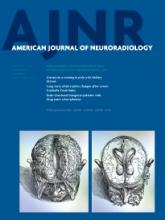Abstract
BACKGROUND AND PURPOSE: The exact prevalence of WM signal abnormalities in healthy relatives of MS patients and their impact on disease development has not been fully elucidated. The purpose of this study was to compare WM signal abnormality characteristics and the prevalence of radiologically isolated syndrome in healthy control subjects selected randomly from the population with the healthy relatives of patients with MS.
MATERIALS AND METHODS: Healthy control subjects (n = 150) underwent physical and 3T MR imaging examinations. Healthy control subjects were classified as non-familial healthy control subjects (n = 82) if they had no family history of MS or as healthy relatives of patients with MS (n = 68) if they had ≥1 relative affected with MS. The presence of radiologically isolated syndrome was evaluated according to the Okuda criteria; dissemination in space on MR imaging and fulfillment of radiologically isolated syndrome criteria were also evaluated according to Swanton criteria.
RESULTS: There was a significantly higher total volume of WM signal abnormality in the healthy relatives of patients with MS compared with the non-familial healthy control subjects (P = .024 for signal abnormality ≥3 mm in size and P = .025 for all sizes). Periventricular localization and the number of lesions in all groups (P = .034 and P = .043) were significantly higher in the healthy relatives of patients with MS; 8.8% of the healthy relatives of patients with MS and 4.9% of non-familial healthy control subjects showed ≥9 WM signal abnormalities; 2.9% of subjects in the healthy relatives of patients with MS group and 2.4% of non-familial healthy control subjects fulfilled radiologically isolated syndrome according to the Okuda criteria, whereas 10.3% and 3.7% of subjects fulfilled radiologically isolated syndrome according to the Swanton criteria. In the healthy relatives of patients with MS, smoking was associated with the presence of WM signal abnormalities, whereas obesity was related to the presence of ≥9 WM signal abnormalities and to fulfillment of radiologically isolated syndrome according to the Swanton criteria.
CONCLUSIONS: The frequency of WM signal abnormalities and radiologically isolated syndrome is higher in the healthy relatives of patients with multiple sclerosis patients compared with non-familial healthy control subjects.
ABBREVIATIONS:
- DAWM
- dirty-appearing white matter
- DIS
- dissemination in space
- HC
- healthy control subject
- non-fHC
- non-familial healthy control subject
- PD
- proton attenuation
- RIS
- radiologically isolated syndrome
- SAV
- signal abnormality volume
- © 2014 by American Journal of Neuroradiology
Indicates open access to non-subscribers at www.ajnr.org












